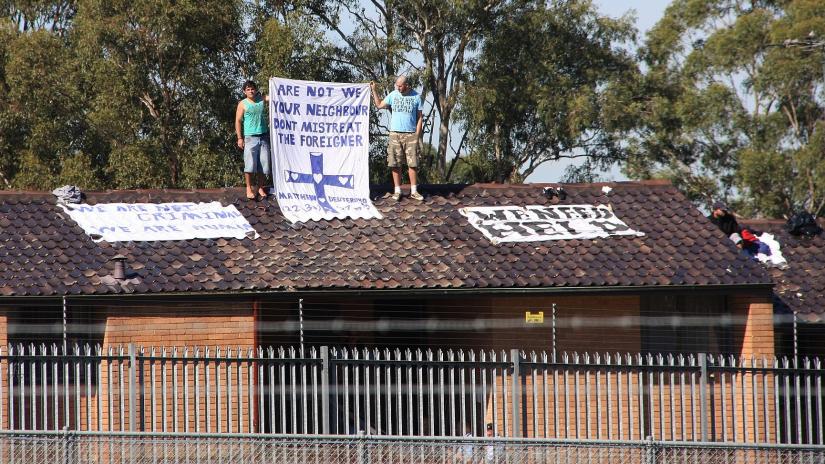How many refugees in immigration detention have been vaccinated? Home Affairs won’t tell us, writes UTS senior lecturer in law Anthea Vogl.

Asylum seekers on the roof of Villawood Immigration Detention Centre. Image: Wikimedia
When the federal government first announced Australia’s COVID vaccination program in January, the eligibility criteria indicated refugees and asylum seekers, as well as certain other non-citizens, would not be able to access free vaccines.
Days later, Health Minister Greg Hunt clarified all visa holders, including refugees and asylums seekers, would be eligible. The initial announcement, however, was revealing.
Although refugees and asylum seekers are, in fact, eligible to be vaccinated for COVID, the government has not ensured or prioritised vaccination for those held in crowded detention centres.
A coalition of refugee law and advocacy organisations asserted earlier this month the government had yet to even make vaccines available to detainees. They added:
This has created an incomprehensible situation where people who would be vaccinated if they were released into the community, are instead trapped in a high-risk environment unable to access a potentially life-saving vaccine.
When asked by The Conversation last week how many people in detention had received vaccinations, the Department of Home Affairs declined to release any data. Instead, a departmental spokesperson said Home Affairs:
continues to liaise with the Department of Health on the rollout of vaccinations for detainees.
It also said the rollout timeline “will depend on supply of the vaccine”, consistent with the Department of Health’s strategy nationally.
Villawood Detention Centre at particular risk
The government’s apparent failure to include immigration detainees in the first phases of the vaccine rollout demonstrates, once again, how it is prioritising border policies over public health and safety.
As the Delta outbreak in NSW worsens, this is particularly dangerous for those being held in Villawood Detention Centre. The facility is located in Canterbury-Bankstown, which is a “local government area of concern” and currently has one of the highest rates of confirmed COVID cases of any LGA in the state.
Approximately 500 people are currently detained in Villawood Detention Centre — the largest, in terms of population, in the country. Across Australia, around 1,486 people in total are being held in immigration detention, including “alternative places of detention”, such as hotels.
Last week, nearly two dozen detainees at Villawood were reportedly awakened in the middle of the night and put on a plane bound for a detention centre in Western Australia. The reason for the detainee transfer is not clear; Australian Border Force would not comment on the operation.
In September 2020, Home Affairs itself said 247 people in closed immigration detention were assessed as particularly vulnerable to COVID.
Home Affairs said in its statement to The Conversation that no detainee has so far contracted COVID in the immigration detention network.
Immigration detention centres are porous places
COVID thrives in confined spaces, which makes people incarcerated in prisons and immigration detention among the most at-risk populations in terms of infection.
Like prisons, immigration detention centres are also porous places. Guards and other workers constantly move in and out of these facilities and into the community. This creates a risk of infection for people in detention, the staff and for the broader community.
Guards and other detention workers are also often casually employed. This means they do not have sick leave and other entitlements to facilitate full compliance with testing and isolation measures. Instead, those in NSW must rely on the goverment’s emergency payments if they need a COVID test or to self-isolate.
Home Affairs and ABF have also not released details of vaccination levels among detention centre staff nationwide.
Following COVID outbreaks in Silverwater and Bathurst jails this month, advocates and experts have renewed calls to immediately release prisoners before the situation becomes catastrophic.
Similar calls were made in relation to immigration detention as soon as the virus broke out over 18 months ago.
What the government should be doing
Under international law, nations have an obligation to ensure the right of access to “health facilities, goods and services” on a non-discriminatory basis. This includes access to vaccinations.
In March, international and regional human rights groups urged governments to guarantee all migrants access to COVID vaccines on an equal basis with their citizens and regardless of nationality or migration status.
There is genuine concern, however that refugees in Australia will fall through the cracks.
Public health campaigns have not specifically targeted or engaged with those in immigration detention as part of the limited $1.3 million in federal government funding specifically earmarked for messaging to so-called “diverse” communities.
Earlier this month, an ABC report revealed the government’s own translated vaccination information was almost eight weeks out of date.
The government should immediately respond to the danger of COVID infection in all sites of incarceration, including immigration detention.
This would involve the urgent release of refugees, asylum seekers and other non-citizens from detention as numerous other countries have done in response to the pandemic. At a bare minimum, the government should make vaccines available.![]()
Anthea Vogl, Senior lecturer, Faculty of Law.
This article is republished from The Conversation under a Creative Commons license. Read the original article.

